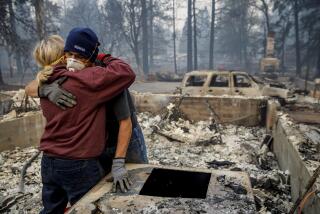Santa Clarita / Antelope Valley : Firefighters Cut Training Pollution : Environment: The Edwards Air Force Base department has switched from smoky jet fuel to cleaner-burning propane for simulated blazes.
EDWARDS AIR FORCE BASE â Faced with increasing environmental consciousness and decreasing budgets, firefighters at Edwards Air Force Base are changing the way they rehearse for the real thing.
Rather than simulating aircraft fires by burning the pollution-producing jet fuel JP-4, firefighters at this sprawling military base are extinguishing blazes fed by comparatively clean propane.
âThis is the next generation of live firefighter training,â said Willie Bell, the baseâs fire chief.
Bell admits that not everyone agrees with his assessment. Disagreement stems mainly from the fact that propane fires do not create the billowy black smoke that is characteristic of flaming jet fuel.
Nonetheless, Bell and Joe Ybarra, assistant chief of training for the base Fire Department, believe environmental concerns, cost savings and the increased control allowed in propane fire simulations will outweigh the lack of smoke.
Master Sgt. Robert W. Rice Jr. of the base Fire Department has fought both real and simulated fires in which jet fuel was burning. He has also battled the simulated propane blazes and feels its lack of smoke is not a significant problem.
âItâs the techniques, how we get to the fire,â Rice said, noting that because the propane fires are so much cheaper and cleaner than the JP-4 blazes, it is expected that base firefighters will get more live fire training.
According to Air Force regulations, Edwards must put its 166 firefighters through at least one night and one day of fire simulation every three months, Ybarra said.
Using live fire training with jet fuel, the Air Force would spend as much as $40,000 annually, he said. The liquid propane simulations are expected to cost just $2,000 a year.
The large-scale propane-burning aircraft mock-up where simulated fires are fought at Edwards is one of a kind, based on a concept developed at Langley Air Force Base in Virginia. Edwards spent $103,000 modifying its jet fuel mock-up to burn liquid propane, and Ybarra estimates that an entirely new facility could be built for $200,000 or less.
By comparison, a fire simulation facility that burns jet fuel would cost $1 million or more, due in part to the need for extensive ground liners to protect underground water.
There is more than cleanliness and cost savings. Propane fires, which came into use at the Edwards training facility about three months ago, can be ignited in 11 areas of the âaircraft,â a feature not available with the jet fuel fire simulations in which a pool of water with JP-4 on top was simply set ablaze, Ybarra said.
More to Read
Sign up for Essential California
The most important California stories and recommendations in your inbox every morning.
You may occasionally receive promotional content from the Los Angeles Times.










